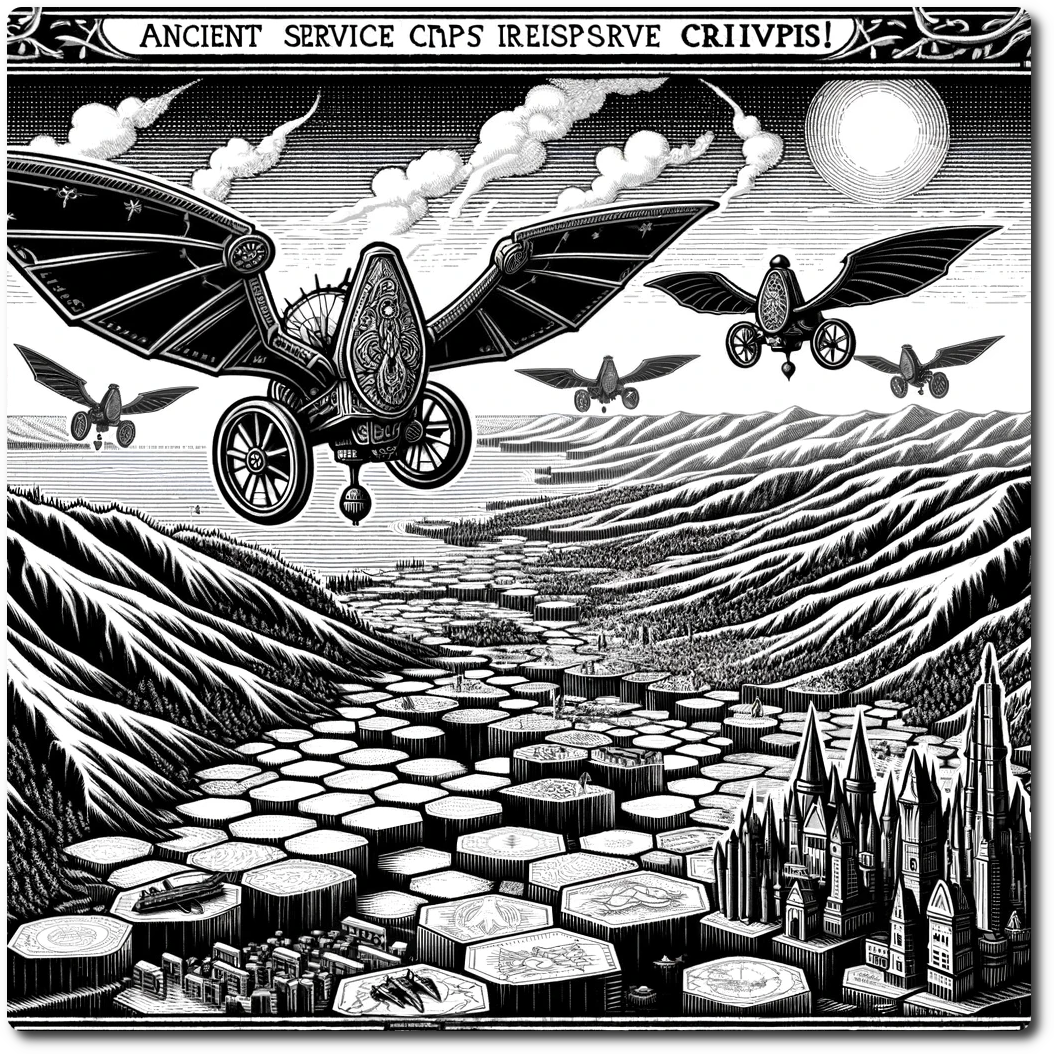
The Crisis!
In the ever-shifting landscape of NeoArcadia, the emergence of a crisis marks a pivotal moment that calls for unity and courage among the scattered adventurers. The Skycaptain, a figure of authority and desperation, initiates the Crisis! event, setting in motion a series of grave challenges and compelling rewards. Here are the mechanics for starting a Crisis! event:
The Crisis! event follows a structured approach to ensure clarity, challenge, and engagement:
- The Skycaptain’s Call
- Resource Assessment
- Crisis Resolution
- Collect Rewards
- Assess Aftermath
1. The Skycaptain’s Call
When the stability of NeoArcadia is at stake, the Skycaptain issues a distress call, an unmistakable sign of dire circumstances. This call is the precursor to a Crisis! event and gathers all the player’s parties to a starting location.
Rallying the Adventurers
- Dispatching Service Craft: The Skycaptain dispatches ancient service craft, remnants of a more advanced era, to deliver the call to action to parties across the wilderness. These crafts symbolize the urgency and gravity of the situation. This happens during the Environment Turn.
- Gathering at the Rally Point: Parties are instructed to converge at a specific hex, the Rally Point, usually NeoArcadia itself. This is to facilitate coordination, resource sharing, and strategic planning. Players may do this during their next turn after the Crisis! is declared. This consumes the parties whole turn.
- Temporary Safe Passage: To expedite the gathering, the Skycaptain ensures temporary safe passage through hexes, reducing the usual risks and allowing parties to reach the Rally Point more efficiently. At the end of the Player’s turn, move the party to the rally point.
2. Resource Assessment
As the reality of the Crisis! event sets in, the adventurers of NeoArcadia must quickly come to terms with their current situation and prepare for the daunting challenges ahead. Resource assessment is a critical phase where parties evaluate their assets, strategize resource allocation, and gear up for the collective effort to confront the crisis. It is also where the initial damage is declared.
- Initial Damage Declaration
- As the Crisis! event begins, the initial consequences are felt immediately. The Crisis! will detail the resources lost as the initial event. This is done during the Environment Turn. This is effectively the resources the players wager by starting a crisis.
- A Crisis! May have a scaling option, this allows larger play groups to scale the Crisis! to a level that is both difficult and fun. If you can solve a Crisis! in a turn, it is not really a Crisis! chum.
- Inventory Check:
- Player conduct a thorough inventory check, listing all available resources, including Gold, Ale, rations, and any special items or artifacts they are will to contribute to the crisis.
- This step ensures that all parties have a clear understanding of their starting point for the crisis, setting the stage for effective resource management. If a player must leave the Crisis before it is resolved, they have an option of rolling back to this point.
- This should also be used to make sure nothing is duplicated or lost as players leave.
Example: Pat commits his geared up fighter and swaps it with Kriss’s Priest. If Pat has to leave and they decide to roll back, Kriss can continue playing with the fighter, and at the end of the Crisis! We know that the fighter was Pat’s and don’t have to worry about where it ends up, it is safely rolled back into Pat’s resources.
- Recording and Transparency:
- All resource assessments, pooling decisions, and strategic plans should be meticulously recorded. This ensures transparency and allows parties to track resource flow, consumption, and replenishment throughout the Crisis! event.
- The use of shared documents or a designated record-keeper can facilitate this process, ensuring that all parties have access to up-to-date information.
3. Crisis Resolution
The Crisis Resolution phase is the climactic conclusion of a Crisis! event, where the combined efforts of all parties are put to the ultimate test. This phase determines the fate of the adventurers and the lands of NeoArcadia, turning the tide towards a triumphant victory or a mournful defeat. Here are the mechanics for the Crisis Resolution.
- Each Crisis! has a set of conditions that must be met for it to end.
- At the end of the environment turn check if the conditions for a Crisis! to be resolved. If so, then follow any instructions from the Crisis! then distribute the rewards.
- Some Crisis! Resolutions are not so good, there represent the response to the Crisis! being to slow.
4. Rewards
Epic Wins:
- A successful resolution of the Crisis! event is celebrated as an epic win, a testament to the bravery, unity, and strategic prowess of the adventurers.
- The parties are rewarded with rich spoils, including rare resources, ancient artifacts, and renown that spreads across the lands of NeoArcadia. These rewards not only reflect the immediate success but also contribute to the long-term development and legacy of the parties.
Tragic Losses:
- Failure to resolve the crisis results in tragic losses, casting a shadow of sorrow and despair over the affected lands and parties. Death is usually the smallest price paid.
- The consequences of failure are significant, including further resource depletion, loss of important characters, and the spread of the crisis’s detrimental effects across NeoArcadia.
5. Assess Aftermath
Once the Crisis! is over, the service craft are sent out once again to gather the parties to the rally point. This gives them a chance to reorganize and settle back in to the steady pace of the Ancient Future, hopefully a little richer for their efforts.
- Players sort out their parties, and resume their turns as normal.